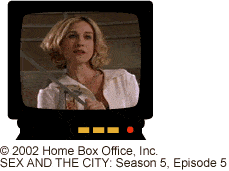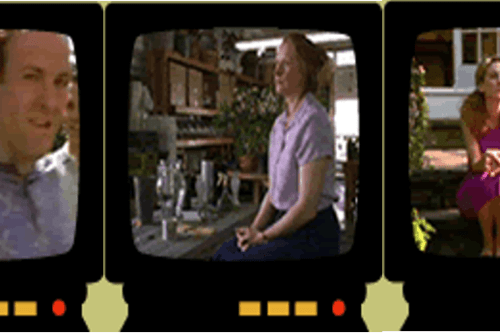One notable side-effect of postcompulsory heterosexuality is a humiliating displacement of the heterosexual male romantic hero. Few men are named, as other critics have observed, and are instead referred to in impersonal classifications (Akass and McCabe 7), sometimes blurring the boundaries between man and accessory. Males vie with products, and in rare instances the two coalesce to their advantage: sporting a vodka bottle between the legs of his nude body, raw food waiter-actor Smith Jerrod becomes a minor celebrity as the Absolut Hunk billboard sensation. He struggles with the phenomenology of becoming-commodity, and resists Samantha’s efforts to contain him in a no-name identity as her role-playing partner and fuck buddy. He insists she learn his name, and once she does, she promptly changes it (from the inopportune Jerry Jerrod), merging the girlfriend role she resists with a more familiar and powerful position as public relations manager (“Lights, Camera, Relationship,” episode 79). With the exception of Big, all of Carrie’s dates compete, often unsuccessfully, with the omnipresent other man, i.e., the Manolo. It seems fitting that in the middle of the final season Carrie makes the single woman’s ultimate declaration of independence and entitlement—”getting married” to herself and registering at the Manolo flagship store—and gives new meaning to the expression “soul mate.”
More generally, suitors are frequently supplanted by the series’ costume closet. The four women, Carrie in particular, embrace a type of female dandyism. For instance, viewers feel that Carrie is acting out of character when Aidan influences her to discard some of her 1980s digs. Resignedly attempting to make closet space for him, she throws the items to the floor with a wince, foreshadowing the union’s doom. Big, whom the series connects with classic New York—its wealth, arrogance, and power, his tinted windows and driver imbuing him with glamour and mystery—is compared in Carrie’s book to the city, his name the first half of a popular Manhattan icon. It is not insignificant that his one-time rival, Aidan, cherishes the country, and the series arguably depicts his modest cabin and resident squirrels as annoyingly rustic, two-bit alongside Big’s black Jaguar, which he drives up from the city to the phonemically appropriate Suffren. Once again, the men are less significant as individual heroes or romantic partners than as markers and bearers of style. Carrie’s one-bedroom apartment serves as a private city, equal parts fashion house, Manolo showroom, and publishing company in miniature. When Aidan purchases the adjacent unit and begins to break down an adjoining brick wall, the effect is one of violation, as if bodily harm is inflicted on Carrie’s person. She sinks to the floor in a full-blown panic attack (“Change of a Dress,” episode 63). A better-fitting union is witnessed in the next season when Carrie descends a white-flower-laden staircase to the accompaniment of processional music (“Plus One Is the Loneliest Number,” episode 71). She enters not a nuptial ceremony but her book launch party, as the voice-over compares finding a publisher to becoming a bride. The series’ withholding of a definite ending for Carrie and Big coupled with Carrie’s success as a writer reaffirms narrative as Carrie’s proper groom. The series creates a mythos of feminine angst as it chronicles the difficulty for Carrie to reconcile her love for the city and its sense of limitless possibility with that of mortal man.

In its graphic catalog of straight sex’s themes and variations, from “tea bagging” to the “to pee or not to pee” question, Sex and the City discloses private conduct as eclectic as the series’ costume closet. Viewers receive 30-minute education sessions in straight diversity, wherein aspects of heterosexuality are revealed as constructed and frequently accompanied by their own set of perversities, a principle utilized by much of feminist media studies and queer theory. Yet, for some viewers, the sense of shock or amusement began to coexist with an “Is this all?” feeling, a Friedanesque (though not suburban) malaise, ameliorated by the series’ nonstop succession of vibrant surfaces. A colleague of mine and out owner of several complete-season DVDs did not especially mourn the show’s finale on HBO, half-asking, half-shrugging, “What are they supposed to do? Have some more sex?” Similarly, Miranda in season 2’s launch interrogated the group’s limited brunch discussion parameters: “All we talk about anymore is big balls or small dicks. How does it happen that four such smart women have nothing to talk about except boyfriends? Does it always have to be about them?” (“Take Me Out to the Ballgame,” episode 13). Such reflexive utterances presciently acknowledged that the series’ risqué dialogue and undercover treatment of sexual trends du jour would not always safeguard against redundancy. As the series boldly depicted the spectrum of contemporary heterosexual mating rituals, judging some more acceptable than others, the characters’ talk about men, however frank, became obligatory, if not monotonous. The limits of the series seem to indicate the worn quality of the defamiliarizing approach, reminding the feminist critic that such a methodology, however thorough, does not necessarily unmask a subversive politics.



